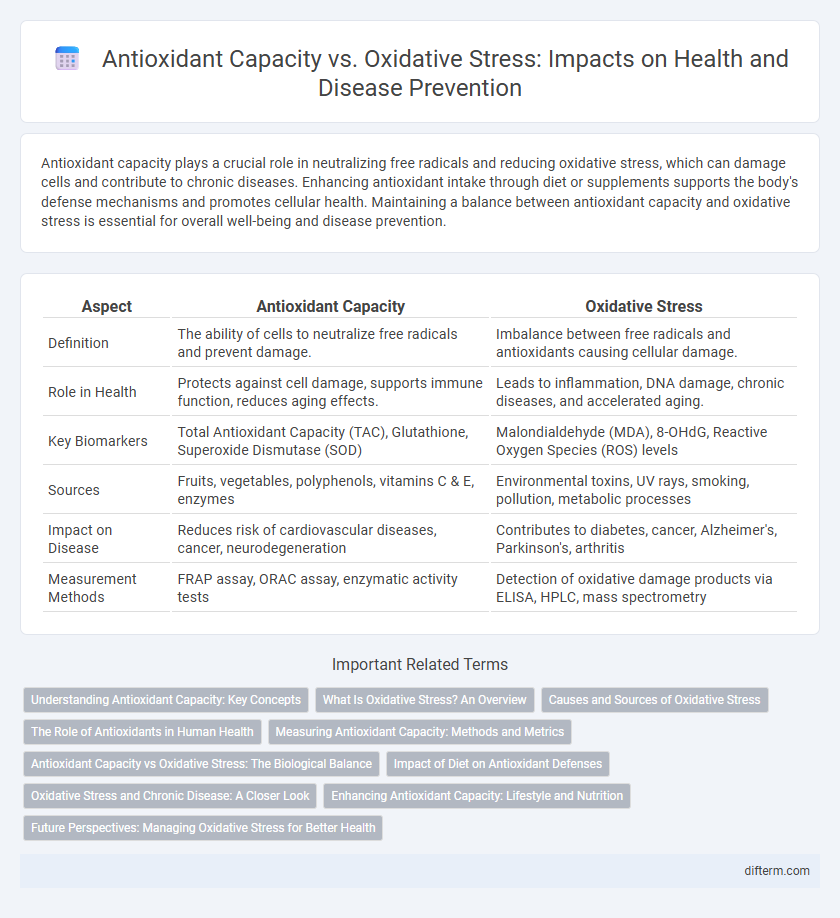Antioxidant capacity plays a crucial role in neutralizing free radicals and reducing oxidative stress, which can damage cells and contribute to chronic diseases. Enhancing antioxidant intake through diet or supplements supports the body's defense mechanisms and promotes cellular health. Maintaining a balance between antioxidant capacity and oxidative stress is essential for overall well-being and disease prevention.
Table of Comparison
| Aspect | Antioxidant Capacity | Oxidative Stress |
|---|---|---|
| Definition | The ability of cells to neutralize free radicals and prevent damage. | Imbalance between free radicals and antioxidants causing cellular damage. |
| Role in Health | Protects against cell damage, supports immune function, reduces aging effects. | Leads to inflammation, DNA damage, chronic diseases, and accelerated aging. |
| Key Biomarkers | Total Antioxidant Capacity (TAC), Glutathione, Superoxide Dismutase (SOD) | Malondialdehyde (MDA), 8-OHdG, Reactive Oxygen Species (ROS) levels |
| Sources | Fruits, vegetables, polyphenols, vitamins C & E, enzymes | Environmental toxins, UV rays, smoking, pollution, metabolic processes |
| Impact on Disease | Reduces risk of cardiovascular diseases, cancer, neurodegeneration | Contributes to diabetes, cancer, Alzheimer's, Parkinson's, arthritis |
| Measurement Methods | FRAP assay, ORAC assay, enzymatic activity tests | Detection of oxidative damage products via ELISA, HPLC, mass spectrometry |
Understanding Antioxidant Capacity: Key Concepts
Antioxidant capacity measures a substance's ability to neutralize free radicals, which are unstable molecules causing oxidative stress and cellular damage. Oxidative stress occurs when there is an imbalance between free radical production and antioxidant defenses, leading to inflammation and chronic diseases. Understanding antioxidant capacity involves evaluating both enzymatic antioxidants, like superoxide dismutase, and non-enzymatic antioxidants, such as vitamins C and E, crucial for maintaining cellular health.
What Is Oxidative Stress? An Overview
Oxidative stress occurs when there is an imbalance between free radicals and antioxidants in the body, leading to cellular damage and contributing to chronic diseases such as cancer, cardiovascular disorders, and neurodegenerative conditions. Antioxidant capacity measures the ability of cells or biological systems to neutralize free radicals and reduce oxidative damage. Understanding oxidative stress is critical for developing nutritional and therapeutic strategies to enhance antioxidant defenses and maintain cellular health.
Causes and Sources of Oxidative Stress
Oxidative stress arises from an imbalance between reactive oxygen species (ROS) production and the body's antioxidant defenses, leading to cellular damage. Common causes include environmental factors such as pollution, ultraviolet radiation, smoking, and exposure to toxins, as well as internal processes like mitochondrial dysfunction and chronic inflammation. Dietary factors, including high intake of processed foods and low consumption of antioxidant-rich fruits and vegetables, also contribute significantly to oxidative stress levels.
The Role of Antioxidants in Human Health
Antioxidants play a crucial role in neutralizing free radicals, thereby reducing oxidative stress that contributes to cellular damage and the progression of chronic diseases such as cardiovascular disorders, diabetes, and neurodegenerative conditions. The body's antioxidant capacity, derived from endogenous enzymes like superoxide dismutase and exogenous sources including vitamins C and E, helps maintain redox balance and protect biomolecules like DNA, proteins, and lipids. Enhancing antioxidant intake through diet or supplementation supports immune function and mitigates inflammation, promoting overall health and longevity.
Measuring Antioxidant Capacity: Methods and Metrics
Measuring antioxidant capacity involves assessing the ability of compounds to neutralize free radicals, using methods such as Oxygen Radical Absorbance Capacity (ORAC), Trolox Equivalent Antioxidant Capacity (TEAC), and Ferric Reducing Antioxidant Power (FRAP). These metrics quantify the efficacy of antioxidants by evaluating their electron-donating or radical-scavenging potential under controlled conditions. Accurate measurement of antioxidant capacity provides critical insight into the body's defense mechanisms against oxidative stress and related cellular damage.
Antioxidant Capacity vs Oxidative Stress: The Biological Balance
Antioxidant capacity represents the body's ability to neutralize reactive oxygen species (ROS) and prevent cellular damage, while oxidative stress occurs when ROS production overwhelms antioxidant defenses, leading to molecular and tissue injury. This biological balance is critical in maintaining cellular homeostasis, as excessive oxidative stress contributes to chronic diseases such as cardiovascular disorders, cancer, and neurodegeneration. Enhancing antioxidant capacity through diet, supplementation, and lifestyle factors can mitigate oxidative damage and support overall health resilience.
Impact of Diet on Antioxidant Defenses
Diet rich in antioxidants, such as vitamins C and E, polyphenols, and carotenoids, significantly enhances the body's antioxidant defenses, reducing oxidative stress by neutralizing free radicals. Consuming a variety of fruits, vegetables, nuts, and whole grains supports the maintenance of cellular integrity and lowers the risk of chronic diseases associated with oxidative damage. Proper nutrient intake directly influences the balance between reactive oxygen species production and antioxidant capacity, promoting overall health and longevity.
Oxidative Stress and Chronic Disease: A Closer Look
Oxidative stress results from an imbalance between free radicals and antioxidants in the body, leading to cellular damage that contributes to chronic diseases such as cardiovascular disease, diabetes, and neurodegenerative disorders. Excessive reactive oxygen species (ROS) overwhelm the body's antioxidant defenses, causing inflammation and DNA damage that impair normal cellular function. Understanding the role of oxidative stress in disease progression highlights the importance of enhancing antioxidant capacity through diet, lifestyle changes, and targeted therapies to mitigate chronic illness risk.
Enhancing Antioxidant Capacity: Lifestyle and Nutrition
Enhancing antioxidant capacity through a diet rich in fruits, vegetables, nuts, and whole grains significantly reduces oxidative stress by neutralizing free radicals. Regular physical activity, adequate sleep, and minimizing exposure to environmental toxins further boost the body's endogenous antioxidant defenses. Incorporating foods high in vitamins C and E, polyphenols, and flavonoids supports cellular protection, reducing the risk of chronic diseases linked to oxidative damage.
Future Perspectives: Managing Oxidative Stress for Better Health
Emerging research on antioxidant capacity emphasizes its crucial role in neutralizing oxidative stress, which is implicated in aging and chronic diseases such as cardiovascular disorders and neurodegeneration. Future perspectives prioritize personalized antioxidant therapies based on genetic and metabolic profiling to optimize oxidative stress management. Innovations in nanotechnology and bioinformatics are expected to enhance targeted delivery and real-time monitoring of antioxidants to improve clinical outcomes.
antioxidant capacity vs oxidative stress Infographic

 difterm.com
difterm.com